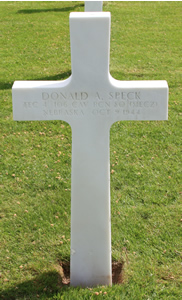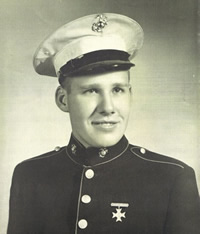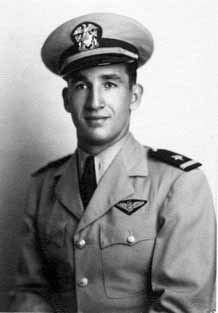 |
Memorial Day Address
Farnam Cemetery
May 28, 2007
by Weldon Hoppe
Duty, Honor, Country
We have come to remember those buried here who served this country and especially those who gave their lives in war that we may live in freedom today. They gave their lives out of duty to country, and now it is our duty to honor them.
Duty, Honor, Country: Those words inscribed on the memorial behind me, are the motto of the United States Military Academy. They were also the title of the farewell speech of General Douglas MacArthur given at the academy in 1962.
If I asked you to name heroes from World War II, General MacArthur would likely be on some of your lists. We often think of the leaders of war as the heroes of war because they are the ones that make the news.
However, another general, General Norman Schwarzkopf of the Persian Gulf War, said in his autobiography "It doesn't take a hero to order men into battle. It takes a hero to be one of those men who goes into battle."
By that measure, we don't need to go far to find heroes. Right here from Farnam and the surrounding community, over seventy-five men and women entered military service to defend our freedom in World War II. If you asked them though, they would probably deny that they were heroes. Most will say they were just an ordinary person in extraordinary circumstances reacting just like any ordinary person would react. They would also say that the real heroes are the ones who didn't get to come home. Whether their motivation was one of duty or one of honor, they all served our country with their lives on the line and deserve our gratitude and remembrance.
At least five men from Farnam lost their lives in World War II and didn't get to come home: Corporal Bernard Murphy, Staff Sergeant Emerald Clement, Technician Donald Speck, Private Marion Brown and Lieutenant (jg) Clinton Wear. We cannot decorate the graves of these five fallen soldiers here because they are not here; they were buried where they died: a prison camp in the Philippines, the countryside of France, the coast of Iwo Jima, and the seas of Japan. They were five of over 400,000 American servicemen who died in World War II. It is our duty to remember them and honor their sacrifices given for our freedom. So, I would like to recall for you today the stories of these five men and their dedication to Duty, Honor, Country.
Corporal Bernard J. Murphy
34th Pursuit Squadron, 24th Pursuit Group, US Army Air Forces
/ /1908 - 7/16/1942
Even before Japan attacked at Pearl Harbor on December 7, 1941, the United States had forces stationed on the Philippines to help defend that U.S. territory. Corporal Bernard Murphy was part of those pre-war forces, as a member of the 34th Pursuit Squadron, 24th Pursuit Group of the U.S. Army Air Forces.
After Pearl Harbor, the U.S. forces stationed on the Philippines were essentially trapped on the islands and were either killed or captured by the Japanese forces. Corporal Murphy became a prisoner of war on May 6, 1942. That is the day of the fall of Corregidor, a tiny island in the entrance to Manila Bay and the last foothold in the Philippines for the American forces. Having lived for several months on severely reduced rations, the American forces were worn down, malnourished and injured or in otherwise poor health when captured. After two weeks of the Japanese "sun treatment" for prisoners, in the sun-baked areas of Corregidor, these troops were taken across Manila Bay to Manila and then by train to Prison camp Cabanatuan (kah-vah-nah-twahn). Corporal Bernard Murphy died at the prison camp on July 16, 1942.
Casualties of the Philippines POW camps O´Donnell and Cabanatuan
Roster of the missing from Bataan and Corregidor
It was not until the camps were liberated at the end of the war and the names of living and dead or missing were determined, that next of kin could be notified. In late October, 1945, over three years after his death, Bernard's father of Farnam, received the following notice:
| |
My deepest sympathy goes to you in the death of your son, Corporal Bernard Murphy, while a prisoner of war of the enemy.
You may have some consolation in the memory that he, along with his comrades-in-arms who died on Bataan and Corregidor and in prison camps, gave his life for his country. It was largely their magnificent courage and sacrifices which stopped the enemy in the Philippines and the final defeat of Japan. Their names will be enshrined in our country's glory forever.
In your son's death I have lost a gallant comrade and mourn with you.
Very faithfully,
Douglas MacArthur
The Farnam Press, November 8, 1945
|
The name of Corporal Murphy is listed on the Tablets of the Missing at the Manila American Cemetery, Manila, Philippines. He was the son of John W. and Agnes Murphy and they are buried at the Murphy cemetery northwest of Farnam.
Staff Sergeant Emerald Clement
2/17/1918 - 7/26/1944
| |
|
|
|
Emerald Clement was twenty-three years old when he reported for duty at Fort Crook in Bellevue on June 27, 1941. He was the oldest son in a family of eight children and was farming with his father near Farnam at the time of his induction.
Three years later found him in France, as a sergeant commanding a squad of men. Just before the battle of St. Lo, he wrote the following letter home to his parents:
|
|
| |
I imagine you are really busy, maybe in the harvest field and going strong. Hope the crops are turning out O.K.
Right now I need a shave and maybe a good wash as a fox hole has been my home for quite a while and I am glad to have it. I guess this is another big maneuver, only this time we dodge the bullets.
I'm squad leader now and have twelve men with myself to look out for.
I've found out the date. The days are all alike though, so I guess the date don't make so much difference.
I can hear church bells off in the distance and they really sound good.
Is Ben still some where in the Pacific? Wouldn't mind meeting up with him. Haven't seen any of the boys from around there.
We like our candy, gum, etc., and they have the most wine and cider around here but can't say I like it so hot.
How's fishing; any luck?
The Farnam Press, July 13, 1944
|
|
Emerald would not get to go fishing again with his family. A month later, his parents received a telegram from the war department stating that he had been killed in action in France on July 26th.
The remains of Staff Sergeant Emerald Clement were returned to the United States in 1948 and buried at Ft. McPherson National Cemetery. He was the son of Claude and Fern Clement and they are buried here in this cemetery.
|
Technician Fourth Class Donald Speck
F Company, 106th Cavalry Reconnaissance Squadron, 106th Cavalry Group, US Army
2/4/1917 - 10/9/1944 (Crion, France)
 Technician Fourth Class Donald Speck was a support specialist in F Company of the 106th Cavalry Reconnaissance Squadron of the U.S. Army. This squadron acted as the eyes and ears of the army, scouting ahead of slower, heavier-equipped armored and infantry units to seek out the enemy. When hostile forces were encountered, it was their job to engage them for the purpose of determining how large and in what position the enemy was to be found, and report this information back to the main command. Technician Fourth Class Donald Speck was a support specialist in F Company of the 106th Cavalry Reconnaissance Squadron of the U.S. Army. This squadron acted as the eyes and ears of the army, scouting ahead of slower, heavier-equipped armored and infantry units to seek out the enemy. When hostile forces were encountered, it was their job to engage them for the purpose of determining how large and in what position the enemy was to be found, and report this information back to the main command.
The 106th landed on Utah Beach in Normandy four weeks after the initial D-Day invasion. They quickly moved forward and joined the battle lines on July 4th, 1944. Three months later they had crossed France and were engaged in the battle for the Forest of Parroy. [Foret de Parroy Combat Studies Institute Battlebook Report] This turned out to be one of the squadron's toughest campaigns of the war. Here, for 2 months in disagreeable weather and extensive minefields, they dismounted and fought alongside the infantry divisions (79th and 44th). The strategic objective of this battle was to capture a major crossroads used by the enemy to supply its forces. That crossroads was captured by the Americans on October 9th, 1944 - the same day that Technician Donald Speck was killed.
His regiment began in Normandy with 1,500 men and ended in Austria with nearly 1,200 of them having received a Purple Heart, 194 of which lost their life. Technician Donald Speck is buried not far from where he died, at Epinal American Cemetery in northeastern France. He was the son of Peter and Mary Speck and they are buried here in this cemetery.
Epinal American Cemetery photos

Private First Class Marion Brown, Jr.
Co. B, 2nd Arm. Amph. Battalion, 23rd Marines, 4th Marine Division, US Marine Corps
9/23/1924 - 2/20/1945
Iwo Jima, a tiny Pacific island, is closely associated with the United States Marine Corps. First, because of the honor earned by the Marines for the successful capture of the island from the Japanese, symbolized by the famous flag raising atop Mount Suribachi, and second, because of the great numbers of Marine casualties suffered in accomplishing that task. [Iwo Jima D-Day diagram]
Private Marion Brown, Jr. of Farnam was part of that assault force, a member of Company B of the 2nd Armored Amphibian Battalion attached to the 23rd Marines of the 4th Marine Division. [Iwo Jima 2nd Armored Amphibian Battalion Operations Report]
His company consisted of 17 amphibious tanks and crews - able to operate on land and in water. Their task was to go in advance of the infantry, to provide artillery cover and fire on enemy positions that threatened the advance. Over 30,000 marines landed on Iwo Jima on the first day of the assault and the amphibious tanks led the way.
After just ninety minutes of the operation, seven of the tanks had been destroyed by the enemy and the crews badly wounded or killed. Most of the rest of the battalion tanks proved ineffective due to the loose sand on the beach and difficulty in advancing up the steep slopes. Private Brown was severely wounded on that first day and died the following day, February 20, 1945. He was buried at sea and his name is listed on the Tablets of the Missing at Honolulu Memorial, Honolulu, Hawaii.

Though he did not live to see the flag on Mount Suribachi raised, his sacrifice helped keep the flag of freedom raised for you and me.
Marion Brown, Jr. was the son of Elwood and Lillie Brown and they are buried here in this cemetery.
Lieutenant Junior Grade Clinton Wear
US Naval Reserve
7/22/1921 - 8/10/1945

Clinton Wear graduated from Farnam High with the Class of 1940. He enlisted in the United States Naval Reserve two years later as an aviation cadet. Three weeks after his enlistment he was married to Patricia Rowland of Farnam. He became a carrier-based navy pilot, flying an FU4 Corsair fighter-bomber.
After Iwo Jima, the U.S. forces turned their attention to Okinawa. Lieutenant Wear's fleet was involved in the Okinawa campaign where he shot down three enemy planes from March 18 to April 12, 1945.
On April 18th his plane went down from enemy fire about 12 miles south of Japan. He survived the crash and spent the night in a rubber raft until rescued the following day by an American rescue party, having been located by the flyer who was his roommate on their ship.
Four months later, on August 9th, the roles were reversed, when his shipmate was shot down. Clinton coaxed his commanding officer to let him go along on the rescue mission. As Clinton was attempting the rescue, his plane crashed and his body and plane were unable to be recovered. This was less than a week before the Japanese surrendered and the war ended.
Besides his young wife, Lt. Wear left behind a six-month old daughter whom he never saw before his death.
Lt. Wear was awarded an Air Medal and eight stars and a Distinguished Flying Cross and star for heroism or extraordinary achievement in aerial combat. His name is listed on the Tablets of the Missing at Honolulu Memorial, Honolulu, Hawaii.

Clinton Wear was the son of Roy and Mary Alice Wear and they are buried here in this cemetery.
These five men answered the call of duty to their country. Their service exemplified the military code of Duty, Honor, Country. In the movie Flags of our Fathers, the narrator sums up the code of honor this way, when speaking of a fallen soldier: "while he may have fought for his country, he died for his friends. For the man in front, for the man beside him. He died so they could fight on." That is the duty that each soldier takes on when he goes into battle, to fight for his country, but to put his life on the line for the success and survival of his friends around him.
Soon after the war, General Dwight Eisenhower, spoke of our duty, or obligations as citizens, when he gave an address at the Nebraska State Fair in Lincoln on September 1, 1946:
| |
Democracy can never be stronger than the readiness of its citizens to sacrifice for it. The privileges of democracy cannot be indefinitely enjoyed unless always there is an equal zeal in meeting the obligations of citizenship under it.
|
In other words, we cannot expect to live in freedom unless we are committed to fulfill our obligations to uphold it. One of those obligations of citizenship, I believe, is our duty to honor those who have given their lives for our country. So, let us remember and honor Bernard Murphy, Emerald Clement, Donald Speck, Marion Brown and Clinton Wear and not just these men, but all those who have died for our country in the defense of freedom.
Notes:
World War II Veterans That Had Farnam Addresses When Entering The Service:
Leslie Beck
Jay Beerman
Dale Beery
Howard Beery
Loren Beery
Noble Bellamy
Dale Boyle
George Boyle, Jr.
Harold Boyle
Clayton Britton
Joe Britton
Carl Brown
Marion Brown*
Laverne Brugger
Leon Caster
Benjamin Clement
Emerald Clement*
Donald (Jack) Cole
Frank Crisman
Gerald Crisman
Dale Crossgrove
Dorothy Crossgrove
Roger Crossgrove
Argil Donner
Kenneth Earhart
Marcus Gaudreault
|
Gerald Hicks
Bernard Hopkins
Earl Hopkins
Leland Hopkins
Lloyd Hopkins
Oren Hopkins
Adam Howat
Bert Howat
Hank Hirschmiller
Claude Ihfe
George Johnson
Lawrence Kiner
Leon Kotschwar
Wray Lydic
Jack Martin
Cliff McMichael, Jr.
Herb McMichael
Arthur McNickle
Glen McNickle
James McNickle
Ralph McNickle
Dale Montgomery
Bernard Murphy*
Cliff Nickerson
Clarence Oberg
Leith Parker
|
Wilson Parker
Barney Ragsdale
Dean Reynolds
Keith Reynolds
Dale Russell
Forrest Saum
Halton Saum
Lawrence Saum
Jack Schultz
Alvin Smallfoot
Donald Speck*
Kenneth Stevens
George Sturgeon
Henry Sturgeon
John Sturgeon
Melvin Sturgeon
Eldon Thompson
George Tillotson
Alfred Wear
Arthur Wear
Clinton Wear*
Gerald Whitney
Russell Wilcox
Dan Wyckoff
Frank Zysset
|
* Killed in Action
Names Source: Farnam History book From These Beginnings We Grew, p. 228
Published: 12/14/2025 - http://www.historicfarnam.us/cemetery/index.asp
Hosted and Published by Weldon Hoppe
|
|

